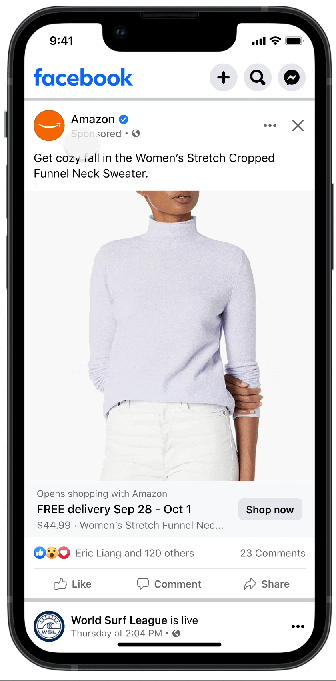
[ad_1]
Meta may have abandoned its efforts around live shopping on Facebook and Instagram, but the social networking company still believes in its apps’ potential as a shopping platform. That leads to today’s news that the company is now working with Amazon to allow customers to link their Facebook and Instagram accounts to their Amazon account to then shop through Meta’s social apps, where they can check out with their saved Amazon payment information and ship to their saved Amazon mailing address.
“For the first time, customers will be able to shop Amazon’s Facebook and Instagram ads and check out with Amazon without leaving the social media apps,” an Amazon spokesperson, Callie Jernigan, confirmed in a statement to TechCrunch. “Customers in the U.S. will see real-time pricing, Prime eligibility, delivery estimates, and product details on select Amazon product ads in Facebook and Instagram as part of the new experience,” she said.
Amazon also noted that the new in-app shopping feature will be available for select products advertised on Facebook or Instagram and sold by Amazon or by independent sellers on Amazon’s storefront.
To get started, it’s a quick one-time setup where customers will link their Meta account (either Facebook or Instagram), to their Amazon account. After this process is complete they can check out with Amazon from the product ad itself, without leaving their Facebook or Instagram app. Their default shipping address and payment information from Amazon will be used to complete the sale.
News of the deal was first leaked by a Meta and Google Ads partner, and co-CEO of Disruptive Digital, Maurice Rahmey. In a LinkedIn post, he explained the benefits of the deal, noting that Meta would gain better targeting and optimization by using information from Amazon and stores that offer Buy with Prime to show consumers ads. This would result in better conversion rates as well, as customers can check out more quickly. Plus, Meta will be able to tailor the ads messaging and product page based on whether or not the user is a Prime member, then adjust other information like real-time pricing or shipping estimates, as needed.

Image Credits: screenshot from Maurice Rahmey’s LinkedIn post
“While additional details are still scarce, this partnership could be a massive revenue opportunity for Meta, Amazon, and most importantly, advertisers,” Rahmey wrote, adding that Meta will get more ads signal and more attributable conversions, while Amazon will get more transactions from large discovery platforms.
In addition, Rahmeny wrote, “Because of the shared data of this partnership, this also bypasses any challenges with Apple’s App Tracking Transparency policy, meaning a true closed loop performance engine.”
Meta has been opposed to Apple’s App Tracking Transparency, or ATT, since the 2021 introduction of the privacy feature, as it claimed it would hurt small businesses that relied on its personalized ads.
Elsewhere among its e-commerce initiatives, Meta has been shifting its Shops sellers to use its own checkout experience on Facebook and Instagram. Meta charges processing fees on those sales, except for shops powered by Shopify. As Amazon is processing its own payments as part of this new deal, it doesn’t appear Meta will be changing fees here.
Amazon benefits from this new arrangement too. The e-commerce giant has tried over the years to create its own versions of social apps like Instagram and TikTok, but they have never really taken off. It shut down its Instagram-like service Spark in 2019, then late last year launched a TikTok-like shopping feed that supports both photos and videos. That service, known as Inspire, became available to all U.S. customers in May. But compared with TikTok itself, Inspire feels overly commercialized, lacking the more influential influencer content that drives sales.
The Meta-Amazon deal comes at a time when TikTok itself is now trying to compete with Amazon, serving as both a discovery engine and e-commerce storefront. With the launch of TikTok Shop, which went live in the U.S. in September, TikTok can reach more than 150 million users. Despite Amazon’s size and clout, that could be seen as a credible threat, particularly given TikTok’s reach with younger Millennial and Gen Z (and even, to some extent Gen Alpha) consumers.

Image Credits: Meta
[ad_2]
Source link






